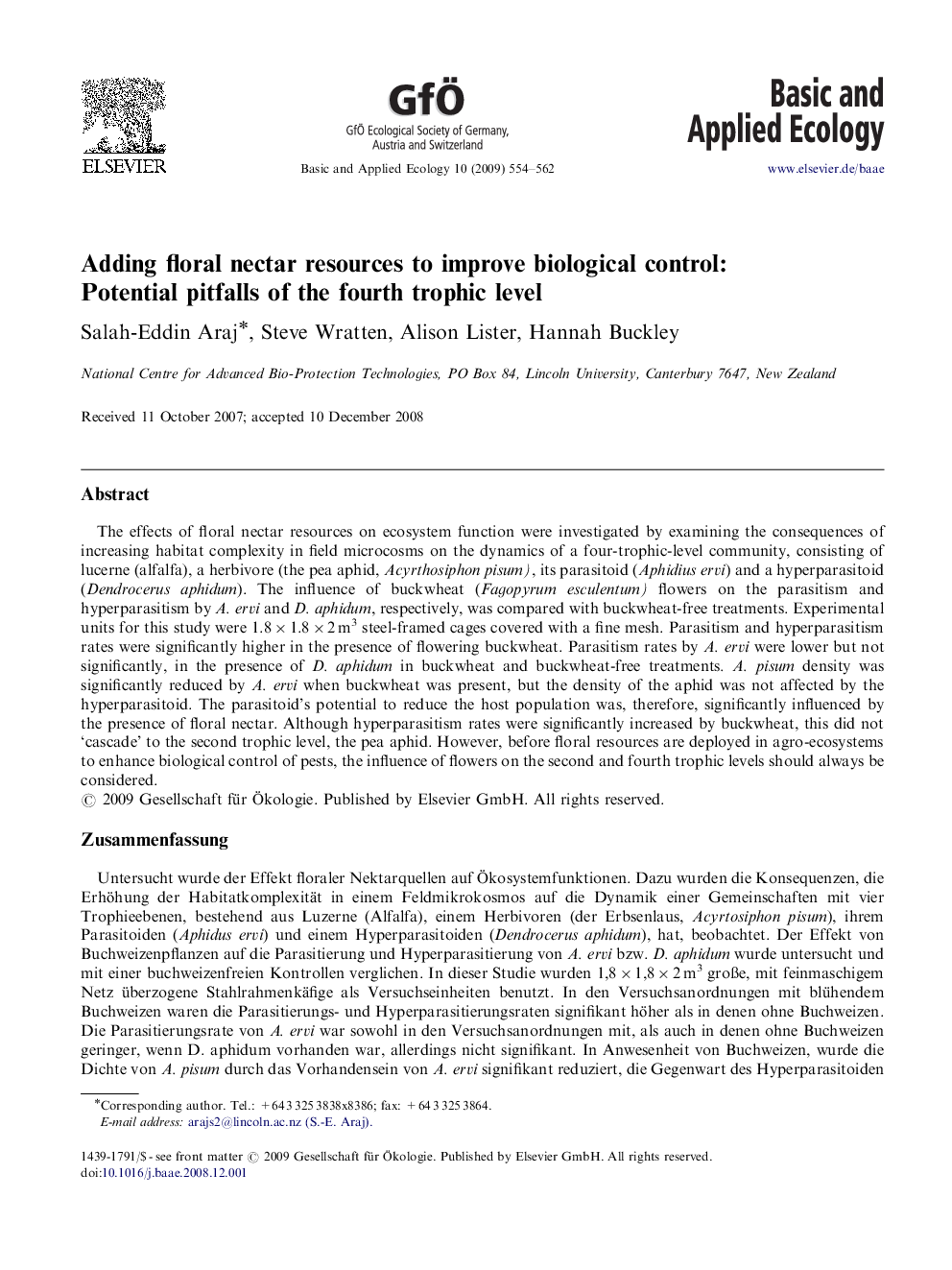| کد مقاله | کد نشریه | سال انتشار | مقاله انگلیسی | نسخه تمام متن |
|---|---|---|---|---|
| 4384779 | 1304435 | 2009 | 9 صفحه PDF | دانلود رایگان |

The effects of floral nectar resources on ecosystem function were investigated by examining the consequences of increasing habitat complexity in field microcosms on the dynamics of a four-trophic-level community, consisting of lucerne (alfalfa), a herbivore (the pea aphid, Acyrthosiphon pisum), its parasitoid (Aphidius ervi) and a hyperparasitoid (Dendrocerus aphidum). The influence of buckwheat (Fagopyrum esculentum) flowers on the parasitism and hyperparasitism by A. ervi and D. aphidum, respectively, was compared with buckwheat-free treatments. Experimental units for this study were 1.8×1.8×2 m3 steel-framed cages covered with a fine mesh. Parasitism and hyperparasitism rates were significantly higher in the presence of flowering buckwheat. Parasitism rates by A. ervi were lower but not significantly, in the presence of D. aphidum in buckwheat and buckwheat-free treatments. A. pisum density was significantly reduced by A. ervi when buckwheat was present, but the density of the aphid was not affected by the hyperparasitoid. The parasitoid's potential to reduce the host population was, therefore, significantly influenced by the presence of floral nectar. Although hyperparasitism rates were significantly increased by buckwheat, this did not ‘cascade’ to the second trophic level, the pea aphid. However, before floral resources are deployed in agro-ecosystems to enhance biological control of pests, the influence of flowers on the second and fourth trophic levels should always be considered.
ZusammenfassungUntersucht wurde der Effekt floraler Nektarquellen auf Ökosystemfunktionen. Dazu wurden die Konsequenzen, die Erhöhung der Habitatkomplexität in einem Feldmikrokosmos auf die Dynamik einer Gemeinschaften mit vier Trophieebenen, bestehend aus Luzerne (Alfalfa), einem Herbivoren (der Erbsenlaus, Acyrtosiphon pisum), ihrem Parasitoiden (Aphidus ervi) und einem Hyperparasitoiden (Dendrocerus aphidum), hat, beobachtet. Der Effekt von Buchweizenpflanzen auf die Parasitierung und Hyperparasitierung von A. ervi bzw. D. aphidum wurde untersucht und mit einer buchweizenfreien Kontrollen verglichen. In dieser Studie wurden 1,8×1,8×2 m3 große, mit feinmaschigem Netz überzogene Stahlrahmenkäfige als Versuchseinheiten benutzt. In den Versuchsanordnungen mit blühendem Buchweizen waren die Parasitierungs- und Hyperparasitierungsraten signifikant höher als in denen ohne Buchweizen. Die Parasitierungsrate von A. ervi war sowohl in den Versuchsanordnungen mit, als auch in denen ohne Buchweizen geringer, wenn D. aphidum vorhanden war, allerdings nicht signifikant. In Anwesenheit von Buchweizen, wurde die Dichte von A. pisum durch das Vorhandensein von A. ervi signifikant reduziert, die Gegenwart des Hyperparasitoiden zeigte jedoch keinen Einfluss. Das Potential des Parasitoiden, die Wirtspopulation zu reduzieren, wurde signifikant durch das Angebot an Pflanzennektar beeinflusst. Obwohl die Anwesenheit von Buchweizen auch die Hyperparasitierungsraten signifikant erhöhte, wurde dieser Effekt nicht auf die zweite Trophieebene, die Erbsenlaus, übertragen. Bevor Blütenpflanzen zur Verstärkung der biologischen Schädlingskontrolle in agraren Ökosystemen eingesetzt werden, sollte immer ihr Einfluss auf die zweite und vierte Trophieebene bedacht werden.
Journal: Basic and Applied Ecology - Volume 10, Issue 6, September 2009, Pages 554–562